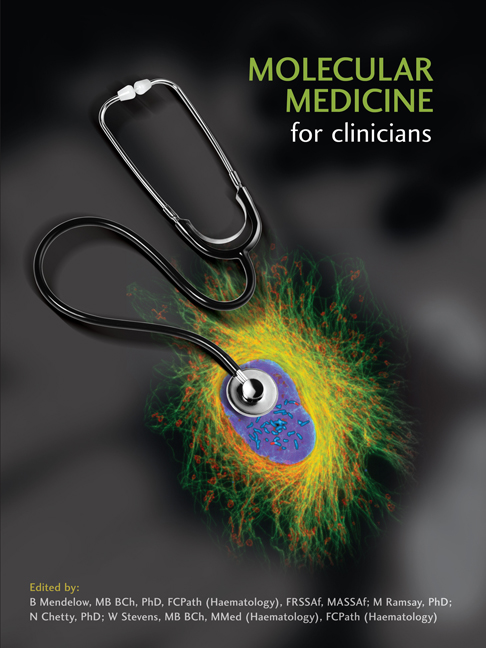Book contents
- Frontmatter
- Contents
- Foreword
- Acknowledgements
- Chapter 1 Introduction
- Keynote Essay 1: Defining Who We Are: DNA in Forensics, Genealogy and Human Origins
- Section 1 Principles Of Cellular And Molecular Biology
- Chapter 2 Digital Concepts in Molecular Medicine
- Chapter 3 The Anatomy and Physiology of the Genome
- Chapter 4 Molecular Cell Biology
- Chapter 5 Genetic Variation
- Chapter 6 Genes in Development
- Chapter 7 Tools of Molecular Medicine
- Keynote Essay 2: The Human Genome
- SECTION 2 MOLECULAR PATHOLOGY
- SECTION 3 MOLECULAR THERAPEUTICS
- SECTION 4 RESEARCH AND THE CONTINUING EVOLUTION OF MOLECULAR MEDICINE
- Glossary
- Contributors’ Biographies
- Source Material And Recommended Reading
- Permissions And Credits
- Index
Chapter 5 - Genetic Variation
from Section 1 - Principles Of Cellular And Molecular Biology
Published online by Cambridge University Press: 04 June 2019
- Frontmatter
- Contents
- Foreword
- Acknowledgements
- Chapter 1 Introduction
- Keynote Essay 1: Defining Who We Are: DNA in Forensics, Genealogy and Human Origins
- Section 1 Principles Of Cellular And Molecular Biology
- Chapter 2 Digital Concepts in Molecular Medicine
- Chapter 3 The Anatomy and Physiology of the Genome
- Chapter 4 Molecular Cell Biology
- Chapter 5 Genetic Variation
- Chapter 6 Genes in Development
- Chapter 7 Tools of Molecular Medicine
- Keynote Essay 2: The Human Genome
- SECTION 2 MOLECULAR PATHOLOGY
- SECTION 3 MOLECULAR THERAPEUTICS
- SECTION 4 RESEARCH AND THE CONTINUING EVOLUTION OF MOLECULAR MEDICINE
- Glossary
- Contributors’ Biographies
- Source Material And Recommended Reading
- Permissions And Credits
- Index
Summary
INTRODUCTION
If an average novel contains about 1000 words per page and the DNA nucleotide sequence of a single germ cell was printed as a book (each nucleotide as one letter), it would result in a tome of about half a million pages! There would be no page numbers, only ‘chapters’ equivalent to our chromosomes. In order to describe the exact position as well as the different kinds of ‘printing error’ that such a vast book may have, a set of universally applied rules is needed. This chapter reviews the spectrum of variation observed in the human genome and briefly outlines a nomenclature for its description specifically related to disease. The nomenclature is based on recommendations from the Human Genome Variation Society (HGVS) published in August 2006.
WHAT IS A VARIANT?
A variant is defined as a structural change in genomic DNA that can be transmitted from one cell to its daughter cell. Strictly speaking, mutational events in humans create new alleles, but in this chapter the term variant will be used in place of allele most of the time. It is general practice to use the term mutation when referring to pathogenic variants, though this is not strictly correct. The term mutation is rooted in the Latin verb mutare – to change – and it refers to any change observed in DNA, pathogenic and non-pathogenic.
HOW DO VARIANTS ARISE?
The main underlying mechanisms through which variants arise include chromosome breakage followed by the loss of DNA or incorrect joining of broken ends, recombination between misaligned chromosomes, gene conversion and errors made during DNA replication and DNA repair. Variants can arise from the incorporation of ‘wrong’ nucleotides during DNA replication, which can occur spontaneously or result from the presence of chemically modified bases in the template DNA. An additional source of variants is the slippage of nascent DNA strands along their template strands during DNA replication.
The rate at which variants are produced can be increased through exposure to mutagens present in the environment (e.g. UV radiation and chemical agents) as well as by the presence of ‘faulty’ DNA replication machinery (e.g. DNA polymerase) that does not copy or proofread newly formed DNA stringently.
- Type
- Chapter
- Information
- Molecular Medicine for Clinicians , pp. 50 - 60Publisher: Wits University PressPrint publication year: 2008



